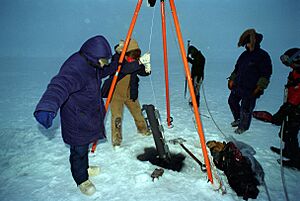Nansen bottle facts for kids
A Nansen bottle is a special tool used by scientists to collect water samples from different depths in the ocean. It was invented in 1894 by a famous explorer named Fridtjof Nansen. Later, in 1966, another scientist named Shale Niskin made an improved version of it. These bottles help us learn about ocean temperature, saltiness, and what lives in the water at various depths.
Contents
How the Nansen Bottle Works
The original Nansen bottle was made of brass metal. It looks like an open tube with a wide cap or valve at each end. These caps are connected by a strong rod.
Scientists attach several Nansen bottles to a long, heavy cable. They place the bottles at specific distances to reach different depths in the ocean.
Once all the bottles are attached and lowered, they wait for a short time. This allows special thermometers on the bottles to get used to the ocean's temperature.
Then, a small, heavy weight called a "messenger weight" is sent down the cable. When this weight hits the first bottle, it triggers a special release. This makes the bottle flip over. As it flips, both caps close tightly, trapping a water sample inside.
The messenger weight then continues its journey. It releases another messenger weight that travels down to the next bottle. This process continues, causing each bottle to flip and collect a water sample in a chain reaction. After all the bottles have collected their samples, the cable is pulled back up to the ship.
Measuring Ocean Temperature
Each Nansen bottle has a special reversing thermometer attached to it. This thermometer measures the exact sea temperature at the depth where the water sample was taken.
A reversing thermometer is a mercury thermometer with a narrow spot in its tube. When the Nansen bottle flips over, this narrow spot breaks the mercury column. This "fixes" the temperature reading, so it doesn't change when the bottle is brought back to the surface.
Ocean pressure can affect thermometers. So, the main thermometer is protected by a strong case. A second, unprotected thermometer is also used. By comparing the readings from both, scientists can figure out both the temperature and the water pressure at that specific depth.
The Niskin Bottle: An Improvement
The Niskin bottle is an improved design patented by Shale Niskin in 1966. It's different from the Nansen bottle in a few key ways:
- It's usually made of plastic. This helps prevent the water sample from getting dirty or contaminated by metal.
- Instead of flipping over, the Niskin bottle is an open tube with caps at both ends. These caps are held open by springs or elastic ropes.
- When the messenger weight hits a Niskin bottle, it triggers both caps to snap shut at the same time. This seals the tube and traps the water sample.
Modern Niskin Bottles
Modern Niskin bottles often use advanced technology. They can have:
- Actuated valves: These are caps that can be set to close automatically at a certain depth. They use a pressure sensor to know when they've reached that depth.
- Remote control: Scientists can also send an electrical signal from the ship to close the caps whenever they want.
Many Niskin bottles can be attached to a circular frame called a rosette. A single rosette can hold as many as 36 bottles! This allows scientists to collect many samples at different depths during one trip.
Modern Niskin bottles also use thermistor temperature sensors. These are electronic sensors that are even more accurate than mercury thermometers for measuring ocean temperature.
See also
 In Spanish: Botella de Nansen para niños
In Spanish: Botella de Nansen para niños



